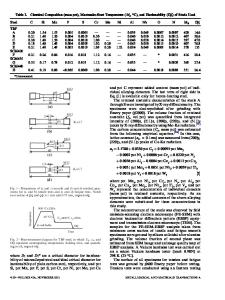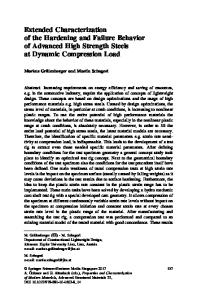Galvanizability of Advanced High-Strength Steels 1180TRIP and 1180CP
- PDF / 922,034 Bytes
- 8 Pages / 593.972 x 792 pts Page_size
- 112 Downloads / 453 Views
TRODUCTION
ADVANCED high-strength steels (AHSS) allow automobile makers to substantially reduce vehicle weight without compromising safety. High fuel prices in recent years have certainly encouraged a broader application of AHSS in the automotive industry. This trend poses a challenge to galvanizers because alloying elements in AHSS, such as Mn and Si, are preferentially oxidized on steel surfaces during annealing prior to hot dipping. The surface oxide layer reduces the wettability of the steel and can result in bare spots and other coating defects. To mitigate the problem, many steel makers choose Al to partly replace Si.[1–3] However, some steel makers still favor Si for better mechanical properties and processability. One of the steels investigated in the present study, 1180TRIP, contains 1.7 pct Si in addition to 2.2 pct Mn in contrast to 1180CP, which contains 2.7 pct Mn and a low level of Si (0.2 pct Si). The oxidation-reduction process can be used to induce internal oxidation of alloying elements in steels and, hence, ensure good galvanizability of the steels.[4–6] It is, however, inconvenient for most galvanizing lines to maintain different dew points at different sections of the annealing furnace. Constant dew points were, therefore, used in both the laboratory study and the production of coatings on 1180TRIP and 1180CP steels. Different types of oxides could form on the steel surfaces during M.S. KIM, Principal Researcher, J.H. KWAK, Senior Principal Researcher, and J.S. KIM, Group Leader, are with POSCO Technical Research Laboratories, Gwangyang, Jeonnam, 545-090, Korea. Y.H. LIU, Senior Scientist, N. GAO, Research Engineer, and N.-Y. TANG, Group Manager, are with the Product Technology Centre, Teck Metals Ltd., Mississauga, ON, Canada, L5K 1B4. Contact email: [email protected]. Manuscript submitted November 21, 2008. Article published online June 24, 2009 METALLURGICAL AND MATERIALS TRANSACTIONS A
annealing, depending on the dew point and the steel composition. In this study, oxides that formed under different conditions were examined and characterized using various techniques. The type and the thickness of the oxides were discussed and related to the coating quality. Measures to improve galvanizability were recommended. In a parallel study, oxidation of alloying elements on 1180TRIP and 1180CP steel substrates was observed in-situ using a scanning electron microscope (SEM) equipped with a hot stage. Computational simulations of the oxidation process were also conducted. Results of those studies will be reported separately.
II.
EXPERIMENTAL
Cold-rolled substrates of transformation-induced plasticity (TRIP) steel 1180TRIP and complex phase (CP) steel 1180CP were produced by POSCO Kwanyang Works. The target tensile strength of these steels was 1180 MPa. Concentrations of major alloying elements in these steels are listed in Table I. Steel panels, 200 mm 9 120 mm in size, were coated using an Iwatani hot-dip simulator located at Posco Kwanyang Works (Kwanyang, Korea). Panels were thoroughly cleaned with
Data Loading...











